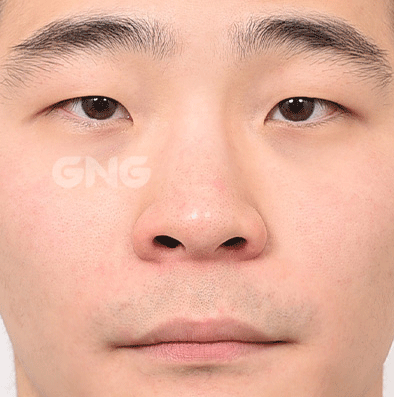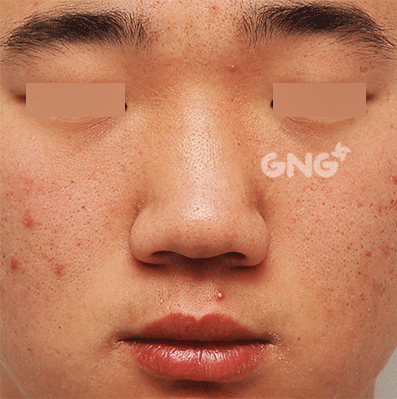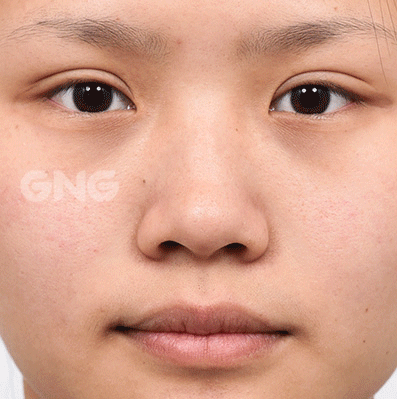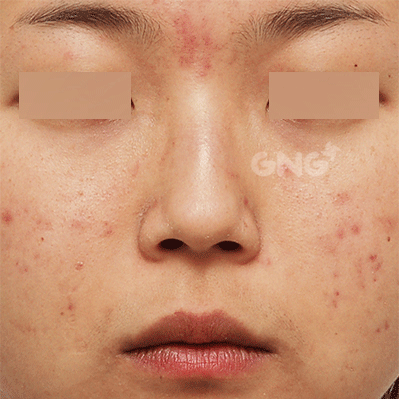Of all the types of facial plastic surgery that can be done to one’s face, rhinoplasty is probably the most popular. In general, though people’s faces vary in many ways, the nose is the most noticeable and varies the most compared to other facial features. It’s also the one feature that makes the biggest difference in one’s facial aesthetics.
Two countries where rhinoplasty is extremely popular are Iran and South Korea. Iranian women tend to have very large, protruded noses, so they undergo rhinoplasty to make their noses smaller. South Korean women tend to have small, flat, and sometimes wide noses, so they want to enlarge their noses. This post will examine different types of noses and what surgical techniques are commonly done to improve each nose type.
Diagram of Nose Parts

Shallow / Low Nose
A shallow nose can make one’s face appear flat. For people with a shallow nose, as is the case for many Asians and Africans, the desire is to increase the height of the dorsum. This can be done to improve comfort when wearing glasses. The solution is to add an implant or, preferably, rib cartilage to the existing nose dorsum to project it outwards.
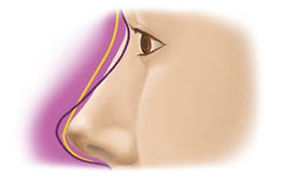
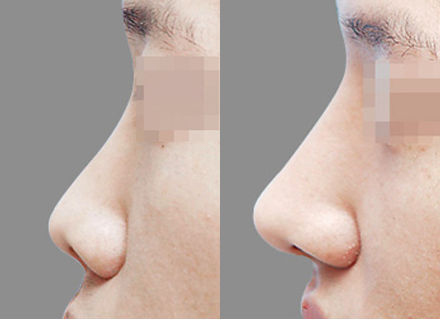

Hump on Nose Dorsum
People who have a hump on their nose can have the hump removed. This is often done by shaving or grinding down the nose bone where the hump is.


Wide Nose
A wide nose can be a nose where the nose sidewalls are wide and/or the nose nostrils are wide.
Wide nose sidewalls
If the nose sidewalls are too wide, then an osteotomy can be performed. In an osteotomy, the base of the left and right nasal sidewall bones are cut or cracked so that the sidewalls can be pushed closer together. After some time, the nose bones will heal.


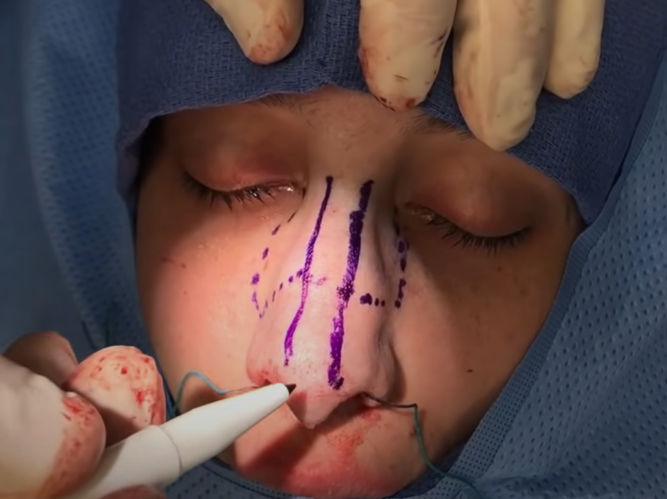



Wide nostrils
If the nostrils are wide, then alarplasty can be performed. There are a few different techniques, but in general, the nostrils are cut where they are connected to the face and then stitched closer together. If necessary, a wedge of the nostril tissue is removed to also reduce the diameter of the nostrils.
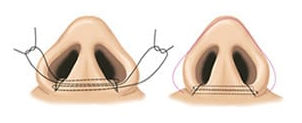
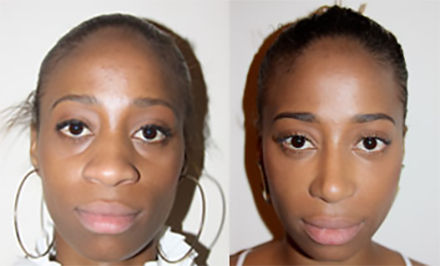
Short / Upturned Nose
When the nose tip is upturned, tipplasty can be performed. With tipplasty, septum or ear cartilage is added to the nose tip to reshape the tip and bring it down a bit.
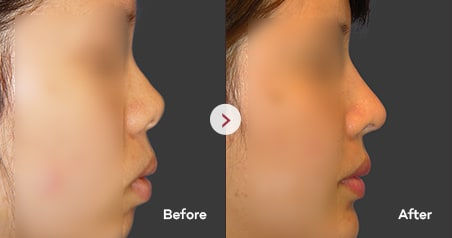

Long Nose
Understandably, it is not possible to reduce the length of the nose from the eyebrows to the tip by cutting the tip of the nose. However, it is possible to raise the nose tip because, in most cases, the nose tip is faced downward. By raising the tip, even though the length of the nose is the same, it may still look better than when the tip is faced downward.
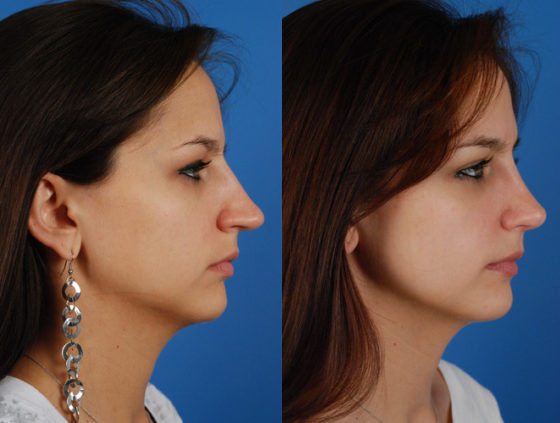
Bulbous Nose
Usually, people with bulbous noses have nose tips that are big and round. This is due to having thick skin and/or large tip cartilage. To improve the appearance of the tip, doctors can remove excess cartilage and, if the skin is thick, remove excess fatty tissue under the skin.
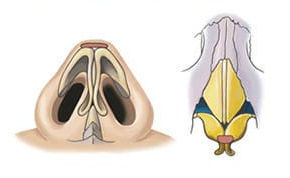
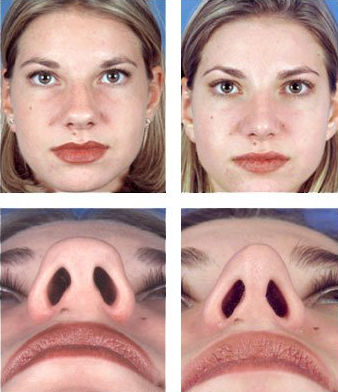
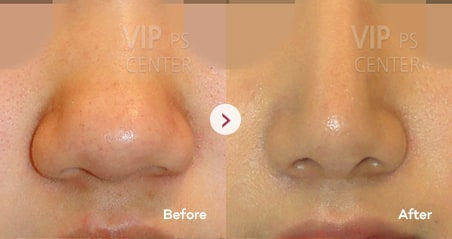
Deviated Nose
Some people’s noses are not straight. This could be caused naturally or due to trauma (an accident). In many cases, the nose is bent. An osteotomy (breaking / cutting the nose bone) can be done to reposition and straighten the bones.

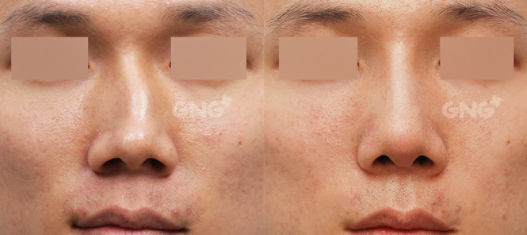
Deviated Septum
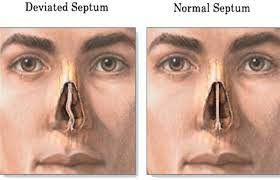
A deviated septum is when the inside wall separating both nasal passages is not straight and centered. This can affect breathing by reducing the amount of airflow or causing an imbalance in the amount of airflow through each nostril. This can be fixed by straightening the septum.
Asian / African Nose
One common feature of Asians and Africans is their noses tend to be wide and low (both bridge and nostrils) and the tips are bulbous. Below is an example before and after picture of an Indian man who had revision rhinoplasty using rib cartilage.
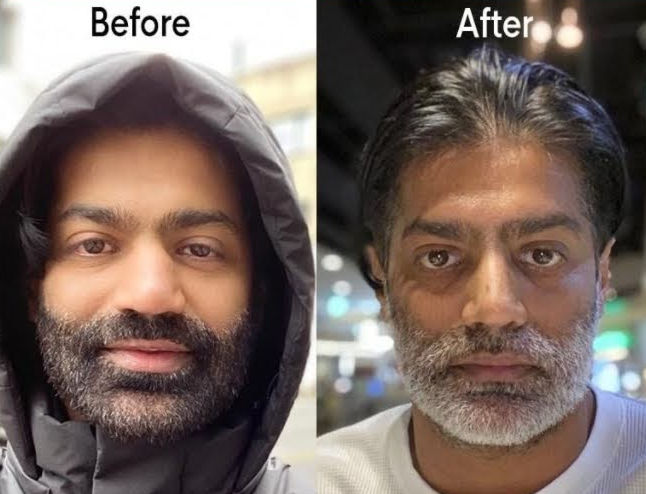
Thick vs Thin Skin
Some people have thin skin and some people have thick skin (literally). There are pros and cons to each.
Thin Skin
- Allows for detailed refinements to be made
- Subtle irregularities and mistakes are more noticeable
Thick Skin
- More difficult to see the result of subtle refinements
- Subtle irregularities and mistakes are less noticeable
- For the bulbous nose tip, must remove excess fatty tissue
Rhinoplasty Clinics
Following are what I’ve found to be the best rhinoplasty clinics. Note that the cost of rhinoplasty in the U.S. is very expensive. Korea is considered the plastic surgery capitol of the world and the costs are a fraction of what they are in the U.S.
U.S.
Korea
- GNG Hospital
- JK Plastic Surgery (accredited by the Korean government)
- JW Plastic Surgery
- VIP Plastic Surgery (Jeju Island)
- Grand Plastic Hospital
- ID Hospital
- VG Plastic Surgery
- Jewelry Plastic Surgery
- Search plastic surgery clinics in Korea
Not only can you fix issues with your nose, but it’s now possible to improve other parts of one’s face, especially in Korea.
Consultation
Before going under the knife, you should consult with multiple surgeons. Following is a case study showing different responses by different rhinoplasty doctors. The patient wanted a narrower, more defined nose with the following changes:
- Alarplasty (to reduce with of the nostrils)
- Tipplasty (to improve shape of bulbous nose)
- Osteotomy (to narrow the nose)
- Bridge augmentation (to slightly increase the height of the bridge) using rib cartilage
- Removal of fibro-fatty tissue at nose tip due to thick skin
Explaining Your Desired Results
It can be difficult trying to explain to a doctor how you want your nose or other parts of your face to look. For that reason, it would be helpful to use a face-editing simulation tool like FaceGen. Learn how to use FaceGen to upload your photo and edit it. Here’s an example.

In FaceGen, you can edit many parts of your face, including your nose, cheekbones, cheeks, jaw, chin, etc.

WARNING
Getting a nose job is not only expensive, but it can possibly alter your appearance and ability to breathe in both a good and BAD way.
Limited Breathing
If you have a wide nose and want to make it narrow, a cosmetic surgeon who isn’t an ENT (Ear, Nose, Throat) doctor may not be aware that having too narrow of a nose may limit breathing through your nose. That’s why some (maybe many) doctors in Korea perform an X-ray and 3D CT scan of your head to determine the shape and thickness of facial bones and where nerves pass.
RECOMMENDATION:
Only choose a doctor who is also an ENT doctor and who will perform an X-ray and CT scan.
Unnatural Appearance
Another risk of doing rhinoplasty is you may end up with an unnatural-looking nose, and everyone would know you got a nose job (think Michael Jackson’s nose). Fortunately, most doctors will not be overly aggressive in reshaping your nose, and they may refuse to work on your nose if you insist on a significantly different nose, e.g. a very slim Caucasian nose shape on a very flat and wide African or Asian nose, and vice versa. Nevertheless, there may still be some doctors (maybe cheap doctors) who will do whatever you ask them, regardless of whether the results will appear unnatural. In your mind, you may imagine that you may look good with a significantly different nose shape, but in reality, you may regret it so much that you will hate going out in public and seeing yourself in the mirror. You may end up becoming depressed, completely stressed out, and unable to focus and enjoy life. Your mind will become preoccupied with regret and disappointment. Needless to say, you want to avoid that as much as possible.
RECOMMENDATION:
* be CONSERVATIVE in the nose shape changes you want
* ensure that your doctor knows how to reshape your nose so that it still looks NATURAL
Small Nostrils
While some people naturally have small nostrils, most people have big enough nostrils that they can fit their finger in them, usually to pick their nose. If you have a large nose and large alars, and you want to make your entire nose smaller, even conservatively smaller, there’s a possibility that your nostrils may become too small for you to comfortably fit your fingers in. You may only be able to barely fit your pinky finger in them. Though it’s unhealthy to pick your nose anyway, it’s a very common habit and sometimes more convenient than trying other methods (nasal rinse, etc) to remove stubborn boogers. Since most people can fit their fingers in their noses, you probably don’t want to make your nose so small and narrow that you can’t do so as well.
RECOMMENDATION:
If you make your nose smaller, including your nostrils, do so such that you can still comfortably fit at least your pinky finger in your nose.
Disproportionate Facial Features
If you have a wide face and nose, regardless of race, and you want to make your nose narrow, you may end up with a face with disproportionately sized features, e.g. a very narrow nose on a very wide face. While you may like your nose by itself, you’ll end up not liking to see your cheeks because they’ll look too wide, resulting in an unnatural-looking face. Again, you should only be conservative in reshaping your nos. Choose a doctor who will maintain harmonious proportions of your facial features.
RECOMMENDATION:
Be conservative in reshaping your nose and consider the WHOLE FACE, not just your nose, when deciding how to reshape your nose so that you maintain balanced, proportional and harmonious facial features so that, as a whole, your entire face will look natural. If your nose job looks natural and your nose size is proportional to other facial features, no one would even notice you got a nose job, even though you did.
Alars
Many people, especially Africans, have very large and wide nostrils due to excessive alar skin. Therefore, it is a very common practice to cut and remove a bit of alar skin and reattach it to the cheek. This can be done so effectively that you can’t even tell that the alars were trimmed and reattached. However, not all doctors are skilled at doing this, and some patients end up with a piggy nose such that their nostrils become very visible despite being smaller. The problem with alarplasty and the trimming of the alars is that once the doctor trims the skin off, it’s gone forever. You can’t undo it. Of all the possible changes you can do to your nose (osteotomy, tipplasty, shaving down a hump on the nasal bridge, etc), the only one that can’t be undone is the trimming off a piece of each alar.
RECOMMENDATION:
If your alars are only slightly large, the risk of trimming them slightly may outweigh the disappointment of having slightly large alars. However, if your alars are too large, then you may have no choice but to trim them to create a normal-sized nose. However, if you trim the alars, you MUST choose a doctor who has a lot of experience doing so and has many before and after pictures showing consistently positive and natural-looking results. REMEMBER: trimming your alars CANNOT be undone, so if the doctor isn’t experienced and proven, you may regret trimming your alars for the rest of your life!
Before and After Pictures
In addition to consulting with the doctor, verifying their skills, years of experience, etc, you MUST review their before and after pictures to see whether the results are acceptable to you and whether the doctor has experience in the specific types of procedures you need (alarplasty, osteotomy, etc). Also, make sure the “after” pictures show symmetry. Many reputable doctors, surprisingly, can’t even make a nose look symmetric. Look at the nostrils in their post-op pictures. If they don’t look consistently symmetric, then in my opinion, the doctor isn’t good enough, and you might as well pay more for a perfectionist doctor.
RECOMMENDATION:
In addition to verifying credentials, years of experience, etc, make sure the doctors’ before and after pictures CONSISTENTLY show acceptable and symmetric results and that the doctor has plenty of experience in the specific types of procedures you need done, especially alarplasty!
Pain
If you get a nose job that doesn’t include harvesting cartilage from your rib, then at most you’ll just feel a lot of pressure on your nose right after the surgery. Depending on the doctor, you may have a lot of bleeding or a little. However, if the doctor removes some rib cartilage to use on your nose, then you’ll feel INTENSE pain at the incision area on your rib when you make even the slightest of movements. For the first night, you’ll want to remain as still as possible and not breathe heavily to minimize the pain. If the pain is too unbearable, you can ask the nurse for a strong painkiller. On day 2, the rib pain will decrease significantly (maybe by 50%), but it will still be very painful. By day 3, it will have decreased even more (maybe by 25%), and so on. By day 4, you’ll still feel some pain, but it will be tolerable.
Swelling
After rhinoplasty, not only will your nose be very swollen, but your whole face will be swollen including your cheeks and possibly your upper throat. It won’t be painful, but it will look painful and you’ll look like a train wreck. The swelling is due to your body reacting and trying to heal itself. It’s very normal and to be expected. In Korea, many doctors will offer daily deswelling treatment including
- oxygen chambers, where you lay in a closed chamber full of oxygen for 10 minutes
- red infrared light, where the light is pointed at your face for 8 minutes
These deswelling treatments are proven and do indeed reduce swelling faster than if you did not do them.
One week post-op, the nurse will remove the cast. Your nose will look bigger than it should because it’s swollen, but it may actually get even bigger now that the cast is off. At this point, your nose will look so different from before the surgery and from what you expect it to look like that you may feel embarrassed and regret having done the surgery. The important thing to keep in mind is that it will take a MINIMUM of one month, possibly longer, for most of the swelling to go away, and in general, it will take one year before you see the final results. The biggest and most drastic changes will occur during the first month, so if you freak out because you look like Michael Jackson, just relax because your nose will change shape as the swelling goes away (unless the doctor did a bad job). During the first month, you may notice that your nose doesn’t look natural at all, or that it looks too big or too protruded or too narrow, or that the nostrils are too small, etc. Again, this is all temporary. The cartilage in the nose tip, for example, will be hard and stiff and may make your nose look very pointy. As the nose heals, the cartilage will soften and the pointy tip will become a softer, rounder more natural-looking tip. The bridge may also look too narrow. Again, cartilage added to the bridge will soften and the overall shape and size of the nose will become softer as the cartilage softens and spreads out. The key thing to remember is that your nose shape will change drastically during the first month, so there’s no need to lose sleep or freak out if what you see doesn’t look good. You just need to be patient and wait for the nose to heal.
Congestion
After rhinoplasty, you can’t blow your nose, sneeze through your nose, or clean your nose. Basically, you must leave your nose alone as much as possible and let it heal. During this time, you will feel congested, and find it difficult to breathe. The nurse may use a special tool to suck blockage from inside your nose daily because the congestion will keep coming back until the nose has completely healed. This is normal, but it is very uncomfortable. After one month, most of the congestion should have gone away.
Stiffness
After rhinoplasty, the area around your nostrils will feel numb or stiff. This can last for a couple of months. The stiffness will dissipate gradually, but in the beginning, it will make it uncomfortable to open your mouth wide or smile. You may even feel like your smile looks unusual for a while. Over time, the stiffness will go away as the area heals and you won’t feel any resistance or discomfort when opening your mouth wide or smiling.
Dry Crusty Feeling Inside Nose
Depending on what the rhinoplasty doctor does, e.g. if he reduces the size of an enlarged turbinate, fixes a deviated septum, or trims large alars, you may experience severe dryness in each nostril, resulting in crusty boogers and severe congestion. You may squirt saline spray into your nose to help moisturize it, but you’ll have to just be patient and wait for the nose to heal and the dryness to go away on its own.
Donald B. Yoo
A virtual consultation was done with Dr. Yoo. Dr. Yoo specializes in rhinoplasty and agreed that he could perform each change.
- No CT scan was done to examine the bone structure.
- He did not feel it was necessary to augment the bridge because the patient’s nose bridge was already high.
- For the bridge augmentation using rib cartilage, he would dice the cartilage and wrap it in fascia.
- For the alar reduction, he would remove just a little bit of skin on both nostrils.
- For the osteotomy, he would only do it on the lower half of the nose.
- Total surgery time would be about 6-7 hours.
- The video consultation costs $150 and that cost would go towards the surgery cost.
- The total cost would be about $33K.
David Kim
Dr. Kim specializes in rhinoplasty.
- No CT scan was done to examine the bone structure.
- He did not feel the need to remove fibro-fatty tissue under the nose tip skin.
- He was uncomfortable performing an osteotomy.
- The in-person consultation cost $150.
Kaiser Permanente Doctor
A doctor at Kaiser Permanente who specializes in rhinoplasty would perform all changes except bridge augmentation.
- No CT scan was done to examine the bone structure
- He didn’t feel the need to do an osteotomy. However, he was open to the idea of doing an osteotomy.
- He didn’t mention anything about removing any fibro-fatty tissue.
- He seemed rushed and not particularly interested.
- His quote was $10K.
- The in-person consultation cost $100.
Dr. Yong-Hae Seong (GNG Hospital)
Dr. Seong founded GNG Hospital. He specializes in rhinoplasty.
- A CT scan was done to examine the bone structure and airways.
- For the tip, he would shape it. However, doing so would result in the tip being higher than the bridge. However, the bridge augmentation in the amount of 2mm would result in the bridge being straight from top to tip.
- The sides of the bridge would be straight, not bumpy.
- For the bridge augmentation using rib cartilage, he would dice the cartilage, shape it, and glue it together using a liquid from the body. He would not wrap the cartilage in fascia.
- For the alar reduction, he would remove 1 mm of skin on both nostrils.
- For the osteotomy, he would only do it on the lower half of the nose and push the bone in by 1 mm on each side for a total narrowing of 2 mm. This is the maximum narrowing he recommended based on the CT scan image because he wanted to be safe and avoid breathing issues that could be caused by aggressive narrowing of the base.
- Even though 1mm and 2mm reductions seem like a little, the end result will be very noticeable.
- GNG hospital always uses general anesthesia on patients, not sedation.
- Total surgery time would be about 5 hours.
- The in-person consultation was free, however, the meeting time with Dr. Seong was only about 5 to 10 minutes.
- The total cost would be about $10K however, you’d get 8% VAT back at the airport when leaving Korea.
RECOMMENDATION:
Dr. Yong-Hae Seong of GNG Hospital is both a rhinoplasty surgeon and an ENT doctor who has 19+ years of experience, including doing osteotomies to narrow the nose, alarplasty to reduce the nose base with and nostrils, tipplasty to reshape the tip, and more. His before and after pictures look good and the results always look natural and symmetric. The cost of doing rhinoplasty in Korea is MUCH cheaper than in the US and you get a tax refund at the airport when you leave, which can amount to around $800 for a $10,000 operation. He is one of the best doctors in Korea and possibly the world! You can’t go wrong if you choose him as your doctor.
https://en.gnghospital.com/sub/doctor/
Kim, Sung-Sik (JK Plastic Surgery)
- No CT scan was done to examine the bone structure and airways.
- He did not want to do an osteotomy because he said that the area needing to be narrowed was cartilage, not bone, and that he could only try to remove some fibro-fatty tissue to help narrow the nose.
- He would do alar reduction.
- He did not want to do bridge augmentation because he felt that the bridge was already high enough. He would do the bridge augmentation but not with rib cartilage because he said rib cartilage was for the tip. He preferred to use a silicone implant for the nose bridge. However, he felt that augmenting the bridge wouldn’t result in a narrower-looking nose but just a larger nose.
- The in-person consultation was free.
- His quote was $7.5K
- The patient would undergo sedation as opposed to general anesthesia.
Suh, Man Kun (JW Plastic Surgery)
Dr. Suh founded JW Plastic Surgery. He specializes in rhinoplasty.
- A CT scan was done to examine the bone structure and airways.
- He would do an osteotomy from bottom to top of nose. At the bottom, he would only push the nose in by about 1mm on each side since bring the nose in narrower may result in breathing problems. He would not just do an osteotomy on the top half of the nose because that would result in a stair-step nose where the top is narrow and the bottom is wide.
- He would cut some of the lower left and right bridge cartilage and align it to make it appear narrower.
- The CT scan showed clear airways and a normal nose structure and only a slight deviated septum which is normal.
- Since the CT scan showed somewhat large airways, the doctor would try to bring lower left and right bridge wall cartilage inwards to be narrower.
- For alar reduction, the doctor would remove about 2 to 3 mm on each nostril.
- The doctor did not feel the need for bridge augmentation but would do it with rib cartilage if desired
- If not bridge augmentation would be performed, the patient would undergo sedation, otherwise, general anesthesia.
- The doctor would remove some of the fibrofatty tissue at the tip of the nose to help shape it and make it less bulbous.
- The doctor was very nice and the time spent consulting with him was about 20 minutes.
- The cost without bridge augmentation would be about $7500. With bridge augmentation, it would be about $“11000. This includes a 10% discount so you would not be able to get 8% back at the airport upon leaving Korea.
- December is a busy time for plastic surgery in Korea because it’s cold so everyone stays home and students are off school. The best time to visit Korea and do the surgery is in either May or October.
Rhinoplasty is expensive and the healing process takes a long time and is uncomfortable. It is also not without risk. If you are not too bothered by your nose, then the risk, cost and discomfort of getting a nose job is not worth it. However, if you are constantly bothered by your nose that it is a great source of insecurity and unhappiness, then for mental health reasons, you are a good candidate for rhinoplasty. Just remember to be conservative in your nose changes and choose a proven, experienced doctor.
Plastic Surgery Tax Refund in Korea
If you do any cosmetic surgery in Korea, you can get a VAT tax refund in the amount of 10% if the medical institution is registered with the Korean government and is on the list of institutions that offer a refund. View the latest list. If your surgery costs $10,000, then you can get $1000 back at the airport when leaving Korea.
Eyes
East Asians often have small eyes with no eye fold. Some people also have eyes that make them look sleepy. As a matter of fact, everyone’s eyes will change shape as we age due to eyelid stretching and the weakening of eye muscles.
It’s now possible to address these issues using various techniques.
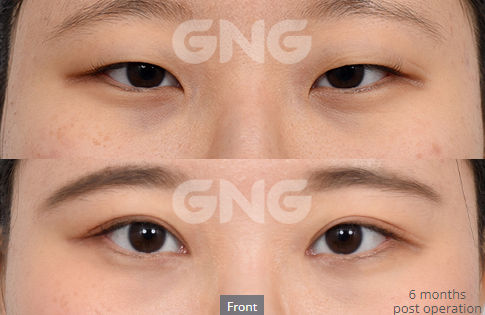

Baggy Eyes
As we age, our eyes tend to become baggy.

Square Jaw Reduction
Some people naturally have very square jaws. It’s possible to remove part of the jaw bone to create a more attractive jaw shape.
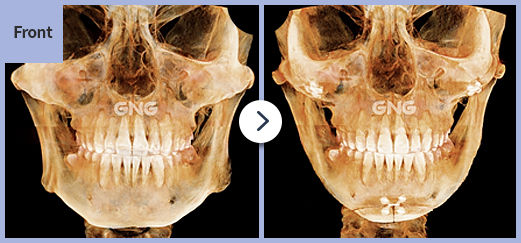
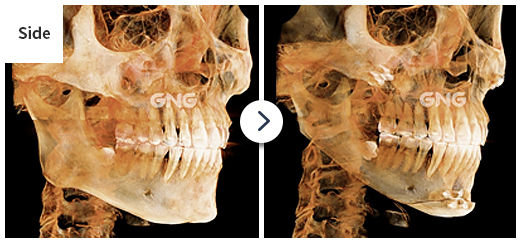
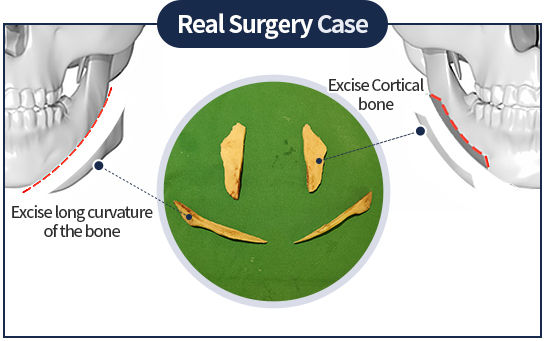
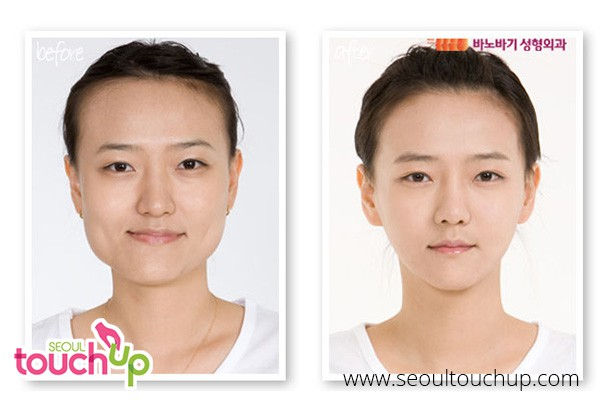
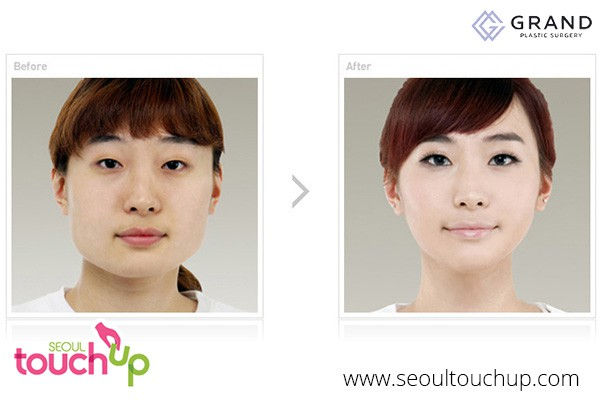


Receding Chin
Some people have very small chins. An osteotomy can be performed to bring the chin forward.

Protruding Chin
If your chin is protruding, an osteotomy can also be performed to remove excess bone that’s causing the protrusion. In the images below, you can see that the chin bone is cut and reattached.
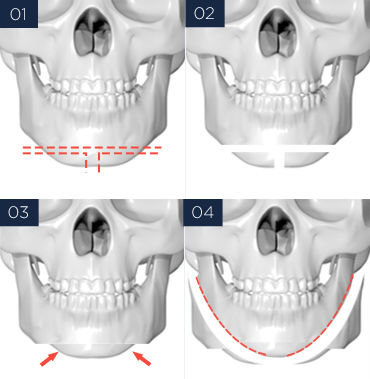

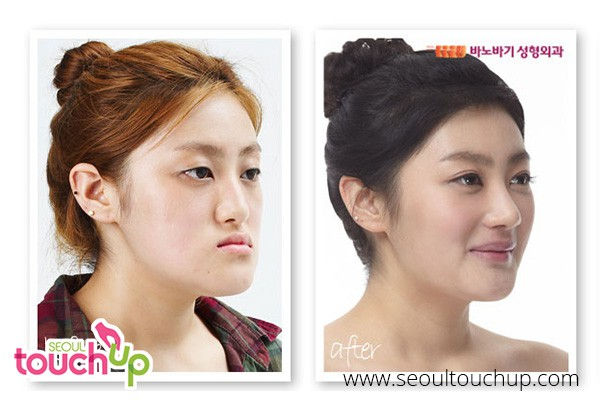
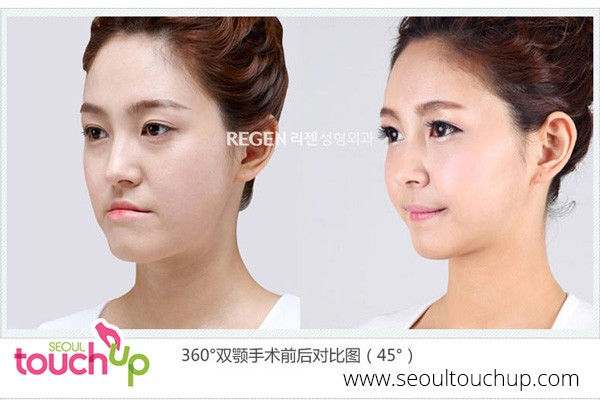
Cheekbone (Zygoma)Reduction
Some people have wide cheekbones resulting in a non-smooth facial contour. Cheekbone reduction surgery can be performed to remove excess bone and move the cheekbones inwards.

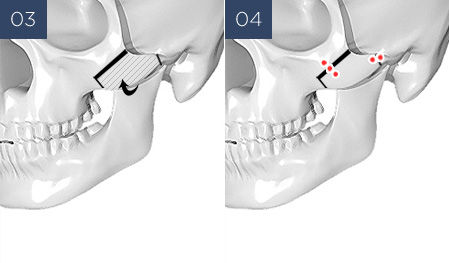
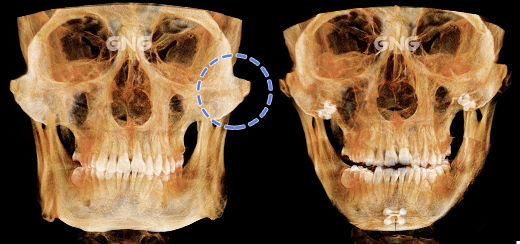

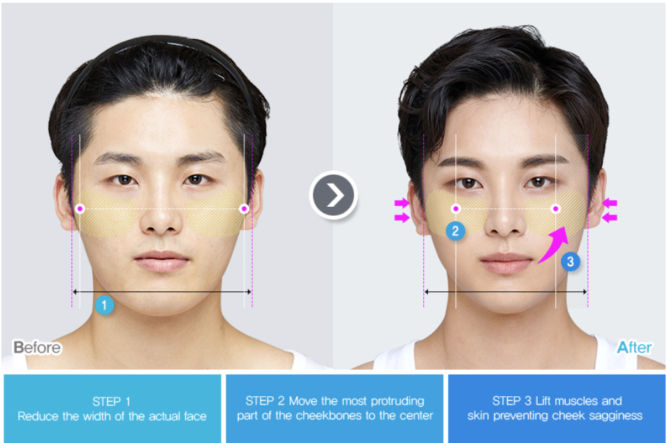
Bumpy or Recessed Forehead
If you have a bumpy or recessed forehead, you can improve the shape by transferring fat to your forehead or by getting a silicon implant.
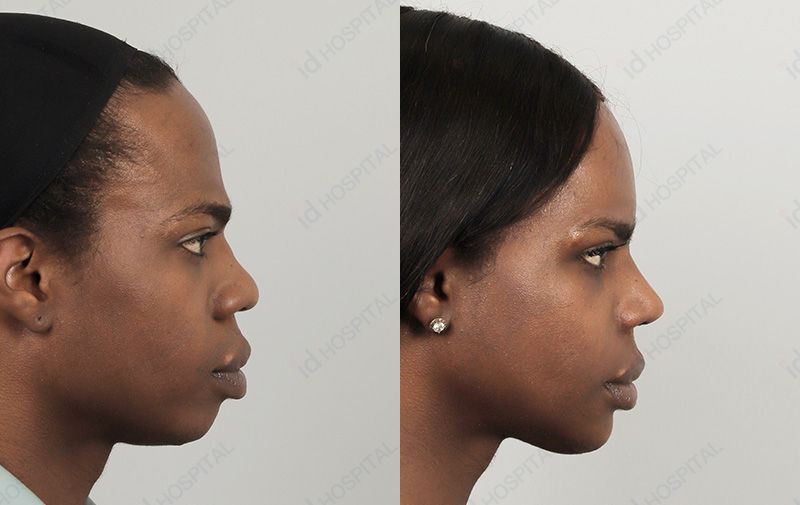
Some Before and After Rhinoplasty Photos
